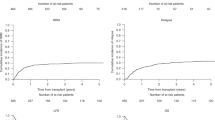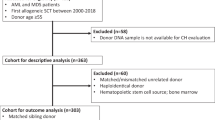Abstract
Genomic loss of the mismatched human leukocyte antigen (HLA) is a recently described mechanism of leukemia immune escape and relapse after allogeneic hematopoietic stem cell transplantation (HSCT). Here we first evaluated its incidence, risk factors and outcome in 233 consecutive transplants from partially HLA-mismatched related and unrelated donors (MMRD and MMUD, respectively). We documented 84 relapses, 23 of which with HLA loss. All the HLA loss relapses occurred after MMRD HSCT, and 20/23 in patients with acute myeloid leukemia. Upon MMRD HSCT, HLA loss variants accounted for 33% of the relapses (23/69), occurring later than their ‘classical’ counterparts (median: 307 vs 88 days, P<0.0001). Active disease at HSCT increased the risk of HLA loss (hazard ratio (HR): 10.16; confidence interval (CI): 2.65–38.92; P=0.001), whereas older patient ages had a protective role (HR: 0.16; CI: 0.05–0.46; P=0.001). A weaker association with HLA loss was observed for graft T-cell dose and occurrence of chronic graft-versus-host disease. Outcome after ‘classical’ and HLA loss relapses was similarly poor, and second transplantation from a different donor appeared to provide a slight advantage for survival. In conclusion, HLA loss is a frequent mechanism of evasion from T-cell alloreactivity and relapse in patients with myeloid malignancies transplanted from MMRDs, warranting routine screening in this transplantation setting.
This is a preview of subscription content, access via your institution
Access options
Subscribe to this journal
Receive 12 print issues and online access
$259.00 per year
only $21.58 per issue
Buy this article
- Purchase on Springer Link
- Instant access to full article PDF
Prices may be subject to local taxes which are calculated during checkout





Similar content being viewed by others
References
Copelan EA . Hematopoietic stem-cell transplantation. N Engl J Med 2006; 354: 1813–1826.
Estey E, Dohner H . Acute myeloid leukaemia. Lancet 2006; 368: 1894–1907.
Kolb HJ . Graft-versus-leukemia effects of transplantation and donor lymphocytes. Blood 2008; 112: 4371–4383.
Pavletic SZ, Kumar S, Mohty M, de Lima M, Foran JM, Pasquini M et al. NCI First International Workshop on the Biology, Prevention, and Treatment of Relapse after Allogeneic Hematopoietic Stem Cell Transplantation: report from the Committee on the Epidemiology and Natural History of Relapse following Allogeneic Cell Transplantation. Biol Blood Marrow Transplant 2010; 16: 871–890.
Gooley TA, Chien JW, Pergam SA, Hingorani S, Sorror ML, Boeckh M et al. Reduced mortality after allogeneic hematopoietic-cell transplantation. N Engl J Med 2010; 363: 2091–2101.
Gress RE, Miller JS, Battiwalla M, Bishop MR, Giralt SA, Hardy NM et al. Proceedings from the National Cancer Institute's Second International Workshop on the Biology, Prevention, and Treatment of Relapse after Hematopoietic Stem Cell Transplantation: Part I. Biology of relapse after transplantation. Biol Blood Marrow Transplant 2013; 19: 1537–1545.
Vago L, Perna SK, Zanussi M, Mazzi B, Barlassina C, Stanghellini MT et al. Loss of mismatched HLA in leukemia after stem-cell transplantation. N Engl J Med 2009; 361: 478–488.
Vago L, Toffalori C, Ciceri F, Fleischhauer K . Genomic loss of mismatched human leukocyte antigen and leukemia immune escape from haploidentical graft-versus-leukemia. Semin Oncol 2012; 39: 707–715.
Villalobos IB, Takahashi Y, Akatsuka Y, Muramatsu H, Nishio N, Hama A et al. Relapse of leukemia with loss of mismatched HLA resulting from uniparental disomy after haploidentical hematopoietic stem cell transplantation. Blood 2010; 115: 3158–3161.
Waterhouse M, Pfeifer D, Pantic M, Emmerich F, Bertz H, Finke J . Genome-wide profiling in AML patients relapsing after allogeneic hematopoietic cell transplantation. Biol Blood Marrow Transplant 2011; 17: 1450–1459 e1451.
Toffalori C, Cavattoni I, Deola S, Mastaglio S, Giglio F, Mazzi B et al. Genomic loss of patient-specific HLA in acute myeloid leukemia relapse after well-matched unrelated donor HSCT. Blood 2012; 119: 4813–4815.
Tamaki H, Fujioka T, Ikegame K, Yoshihara S, Kaida K, Taniguchi K et al. Different mechanisms causing loss of mismatched human leukocyte antigens in relapsing t(6;11)(q27;q23) acute myeloid leukemia after haploidentical transplantation. Eur J Haematol 2012; 89: 497–500.
Dubois V, Sloan-Bena F, Cesbron A, Hepkema BG, Gagne K, Gimelli S et al. Pretransplant HLA mistyping in diagnostic samples of acute myeloid leukemia patients due to acquired uniparental disomy. Leukemia 2012; 26: 2079–2085.
Smith AG, Fan W, Regen L, Warnock S, Sprague M, Williams R et al. Somatic mutations in the HLA genes of patients with hematological malignancy. Tissue Antigens 2012; 79: 359–366.
Coppage M, Iqbal A, Ahmad A, Becker MW . Leukemia specific loss of heterozygosity of MHC in a CLL patient: disease state impacts timing of confirmatory typing. Hum Immunol 2013; 74: 41–44.
Masuda K, Hiraki A, Fujii N, Watanabe T, Tanaka M, Matsue K et al. Loss or down-regulation of HLA class I expression at the allelic level in freshly isolated leukemic blasts. Cancer Sci 2007; 98: 102–108.
Gupta M, Raghavan M, Gale RE, Chelala C, Allen C, Molloy G et al. Novel regions of acquired uniparental disomy discovered in acute myeloid leukemia. Genes Chromosomes Cancer 2008; 47: 729–739.
Raghavan M, Smith LL, Lillington DM, Chaplin T, Kakkas I, Molloy G et al. Segmental uniparental disomy is a commonly acquired genetic event in relapsed acute myeloid leukemia. Blood 2008; 112: 814–821.
van Rood JJ, Roelen DL, Claas FH . The effect of noninherited maternal antigens in allogeneic transplantation. Semin Hematol 2005; 42: 104–111.
Ruggeri L, Capanni M, Urbani E, Perruccio K, Shlomchik WD, Tosti A et al. Effectiveness of donor natural killer cell alloreactivity in mismatched hematopoietic transplants. Science 2002; 295: 2097–2100.
Apperley J, Carreras E, Gluckman E, Masszi T ESH-EBMT Handbook on Haematopoietic Stem Cell Transplantation Forum Service Editore Genova, Italy, 2012.
Mazzi B, Clerici TD, Zanussi M, Lupo Stanghellini MT, Vago L, Sironi E et al. Genomic typing for patient-specific human leukocyte antigen-alleles is an efficient tool for relapse detection of high-risk hematopoietic malignancies after stem cell transplantation from alternative donors. Leukemia 2008; 22: 2119–2122.
Ciceri F, Bonini C, Stanghellini MT, Bondanza A, Traversari C, Salomoni M et al. Infusion of suicide-gene-engineered donor lymphocytes after family haploidentical haemopoietic stem-cell transplantation for leukaemia (the TK007 trial): a non-randomised phase I-II study. Lancet Oncol 2009; 10: 489–500.
Peccatori J, Forcina A, Clerici D, Crocchiolo R, Vago L, Stanghellini MT et al. Sirolimus-based graft-versus-host disease prophylaxis promotes the in vivo expansion of regulatory T cells and permits peripheral blood stem cell transplantation from haploidentical donors. Leukemia 2014; e-pub ahead of print 4 June 2014; doi:10.1038/leu.2014.180.
Luznik L, O'Donnell PV, Fuchs EJ . Posttransplantation cyclophosphamide for tolerance induction in HLA-haploidentical bone marrow transplantation. Semin Oncol 2012; 39: 683–693.
Wang Y, Liu DH, Liu KY, Xu LP, Zhang XH, Han W et al. Long-term follow-up of haploidentical hematopoietic stem cell transplantation without in vitro T cell depletion for the treatment of leukemia: nine years of experience at a single center. Cancer 2013; 119: 978–985.
Di Bartolomeo P, Santarone S, De Angelis G, Picardi A, Cudillo L, Cerretti R et al. Haploidentical, unmanipulated, G-CSF-primed bone marrow transplantation for patients with high-risk hematologic malignancies. Blood 2013; 121: 849–857.
Schmid C, Schleuning M, Schwerdtfeger R, Hertenstein B, Mischak-Weissinger E, Bunjes D et al. Long-term survival in refractory acute myeloid leukemia after sequential treatment with chemotherapy and reduced-intensity conditioning for allogeneic stem cell transplantation. Blood 2006; 108: 1092–1099.
Passweg JR, Baldomero H, Gratwohl A, Bregni M, Cesaro S, Dreger P et al. The EBMT activity survey: 1990-2010. Bone Marrow Transplant 2012; 47: 906–923.
Petersdorf EW . Optimal HLA matching in hematopoietic cell transplantation. Curr Opin Immunol 2008; 20: 588–593.
Appelbaum FR, Gundacker H, Head DR, Slovak ML, Willman CL, Godwin JE et al. Age and acute myeloid leukemia. Blood 2006; 107: 3481–3485.
Rao AV, Valk PJ, Metzeler KH, Acharya CR, Tuchman SA, Stevenson MM et al. Age-specific differences in oncogenic pathway dysregulation and anthracycline sensitivity in patients with acute myeloid leukemia. J Clin Oncol 2009; 27: 5580–5586.
Schneider F, Hoster E, Schneider S, Dufour A, Benthaus T, Kakadia PM et al. Age-dependent frequencies of NPM1 mutations and FLT3-ITD in patients with normal karyotype AML (NK-AML). Ann Hematol 2012; 91: 9–18.
Acknowledgements
This work was supported by the Italian Ministry of Health, by the Italian Ministry of University and Research, by the Cariplo Foundation, by the Associazione Italiana per la Ricerca sul Cancro (Investigator Grant to KF and Start-Up Grant to LV), by the Conquer Cancer Foundation and by the European Commission. The sponsors of the study had no role in study design, data collection, data analysis, data interpretation or writing of the report. The corresponding author had full access to all the data in the study and had final responsibility for the decision to submit for publication.
Author Contributions
LaC, RC, KF, FC and LV designed the study. LaC, RC and AS performed the statistical analysis. CT, BM, FS, LoC, EZ, KF and LV performed the experiments and analyzed the data for the immunogenetic studies. LaC, RG, MTLS, AA, MGC, SM, MM, CC, MB, JP, FC and LV contributed to patient clinical care and data collection. ClB and ChB provided scientific advice and supervision. LaC, FC and LV wrote the manuscript. All authors have approved the final version of the manuscript.
Author information
Authors and Affiliations
Corresponding author
Ethics declarations
Competing interests
Professor Claudio Bordignon is an employee of MolMed SpA, Milano, Italy. Dr Chiara Bonini is a scientific consultant of MolMed SpA, Milano, Italy. The remaining authors declare no conflict of interest.
Rights and permissions
About this article
Cite this article
Crucitti, L., Crocchiolo, R., Toffalori, C. et al. Incidence, risk factors and clinical outcome of leukemia relapses with loss of the mismatched HLA after partially incompatible hematopoietic stem cell transplantation. Leukemia 29, 1143–1152 (2015). https://doi.org/10.1038/leu.2014.314
Received:
Revised:
Accepted:
Published:
Issue Date:
DOI: https://doi.org/10.1038/leu.2014.314
This article is cited by
-
Relapse of acute myeloid leukemia after allogeneic stem cell transplantation: immune escape mechanisms and current implications for therapy
Molecular Cancer (2023)
-
Second haploidentical stem cell transplantation (HAPLO-SCT2) after relapse from a first HAPLO-SCT in acute leukaemia—a study on behalf of the Acute Leukaemia Working Party (ALWP) of the European Society for Blood and Marrow Transplantation (EBMT)
Bone Marrow Transplantation (2023)
-
Chimerism analysis for clinicians: a review of the literature and worldwide practices
Bone Marrow Transplantation (2022)
-
Downregulation of HLA class II is associated with relapse after allogeneic stem cell transplantation and alters recognition by antigen-specific T cells
International Journal of Hematology (2022)
-
HLA-haplotype loss after TCRαβ/CD19-depleted haploidentical HSCT
Bone Marrow Transplantation (2021)



